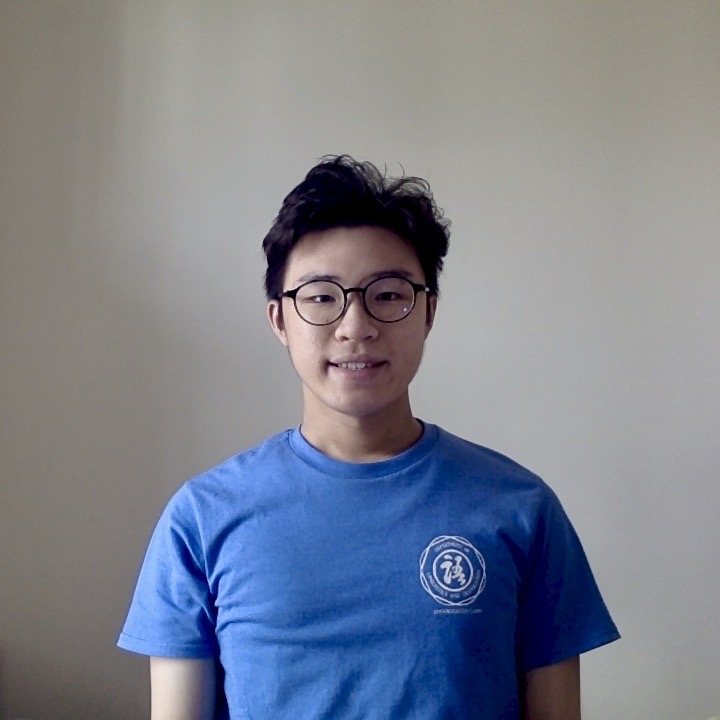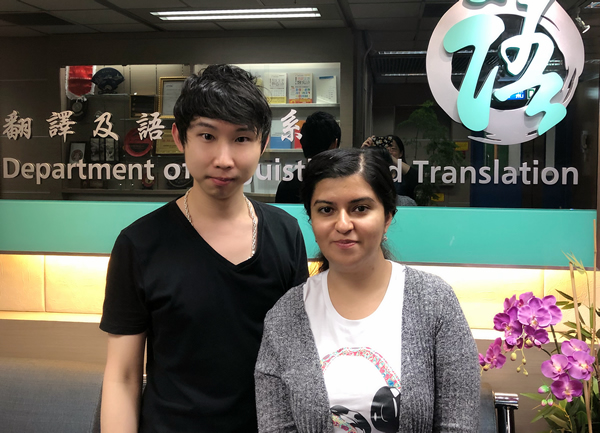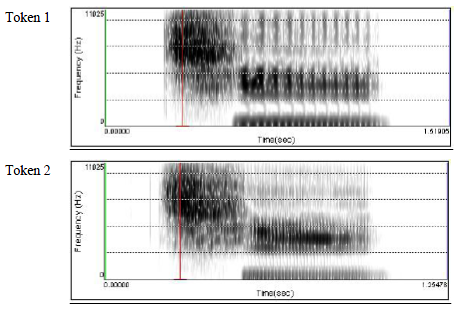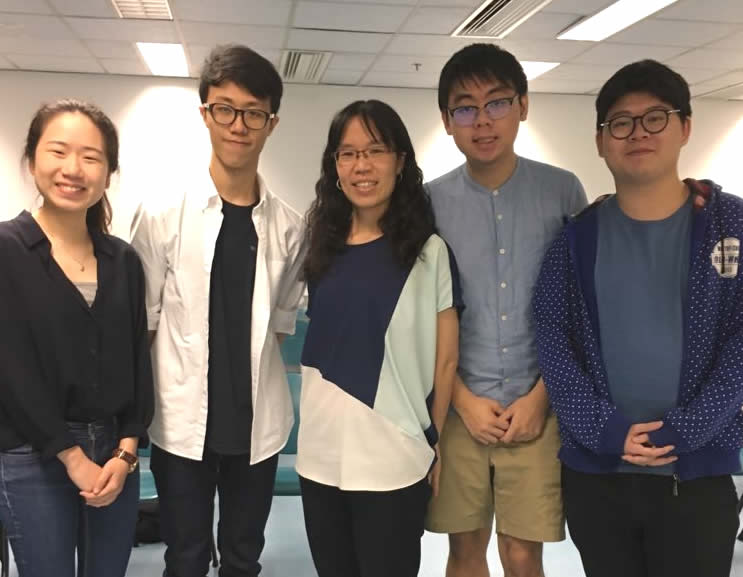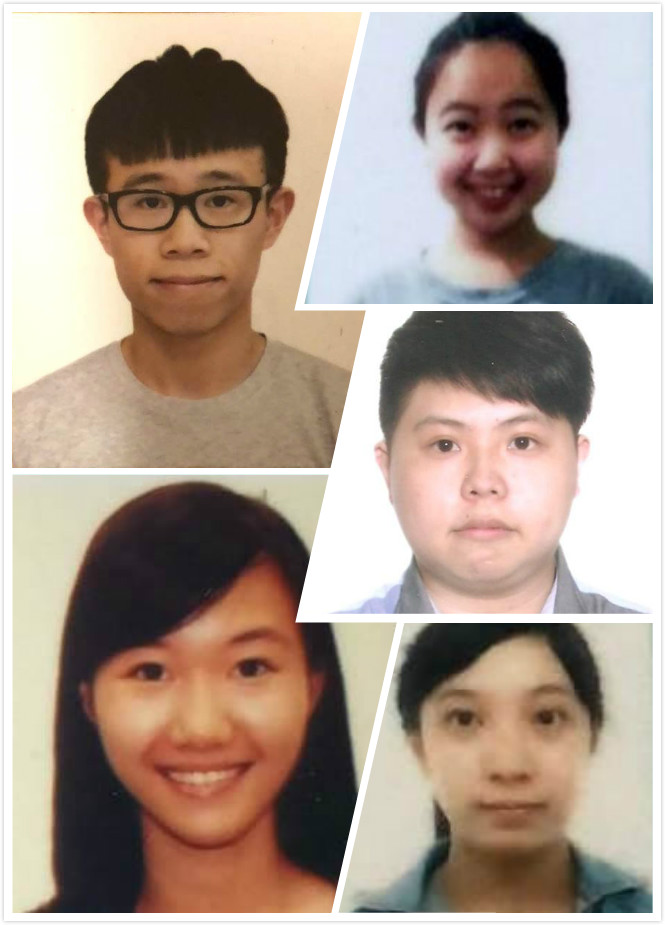2014-15
LT2204 Language and Mind
2019-2020
Word Association and Word Games
| Students | Teacher |
|---|---|
|
HO, Chun Hei, Year 2, BALLA |
Dr. CHAN, Yuet Hung Cecilia |
This project investigated into the relationship between the mental lexicons of people and the social and culture environment, as well as the pattern of word association among L2 English speakers. 15 Hong Kong participants and 15 non-Hong Kong participants completed the experiment, and 15 selected English words will be used for experiment, in which some are expected to get culturally specific results whilst some are related to contemporary global issues. The results suggested that the social and culture environment played an important role in forming the mental lexicons of people, aligning with the findings of Harrison (2015), as Hong Kong and non-Hong Kong participants came up with significantly different responses towards the same set of English words. Moreover, the vast majority of responses in the word association experiment are of semantic links rather than phonological links, which is in contrast with the findings of Read (1993). Two word games are also produced based on the findings in the experiment.
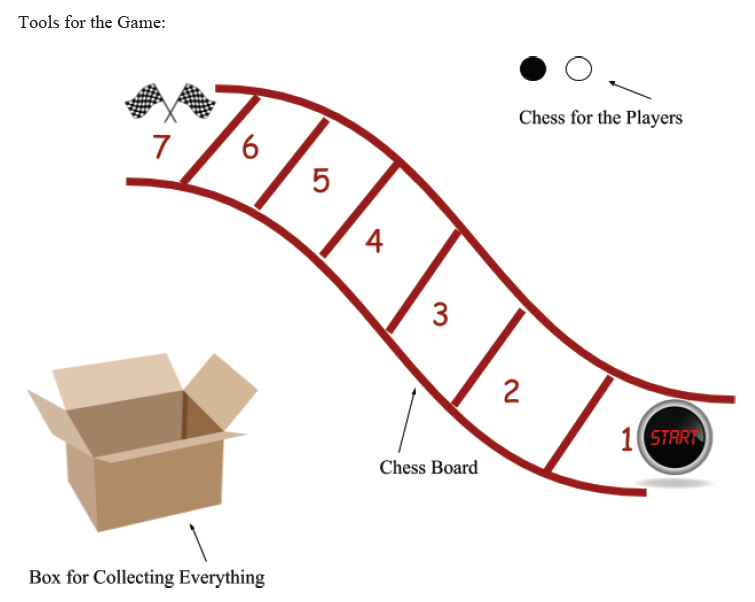
LT2204 Language and Mind
2018-2019
Word Association and Word Games
| Students | Teacher |
|---|---|
|
CHAU, Pak Hei, Year 3, BALLA LAM, Kit Yu, Year 3, BALLA |
Dr. CHAN, Yuet Hung Cecilia |
This experiment aims at studying word association from linguistics, cultural, historical, and psychological perspectives. A total of 60 people from Hong Kong and mainland China were chosen as our participants. This project not only studies the differences between the responses from HongKongers and mainlanders, but also studies word association in general. Some neutral words, which could possibly be connotated positively, neutrally or negatively, were also chosen as some of our primes. Additionally, we found that era may affect the dominance of sense relation in particular primes. Also, our first game aims at strengthening players’ memory skills and attention. Our second game aims at thrilling players and strengthening their ability to react to associated words.
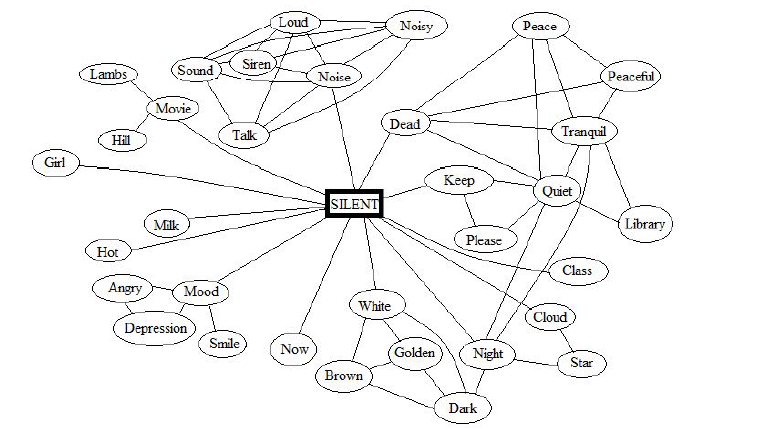
LT2204 Language and Mind
2015-2016
Word Association and Word Games
| Students | Teacher |
|---|---|
|
LO, Tsz Yan Kate, Year 3, BALLT LUI, King Yan Karen, Year 3, BALLT |
Dr. CHAN, Yuet Hung Cecilia |
In this project, a word association experiment that aimed at investigating sense relations between word stimuli and word responses given by participants was conducted. The sense relation most frequently appeared and the effects of parts of speech of word stimuli on the occurrences of different sense relations between stimuli and responses were discovered. The explanations for the findings of the experiment were given. Two word games were created by using the responses obtained from the experiment.
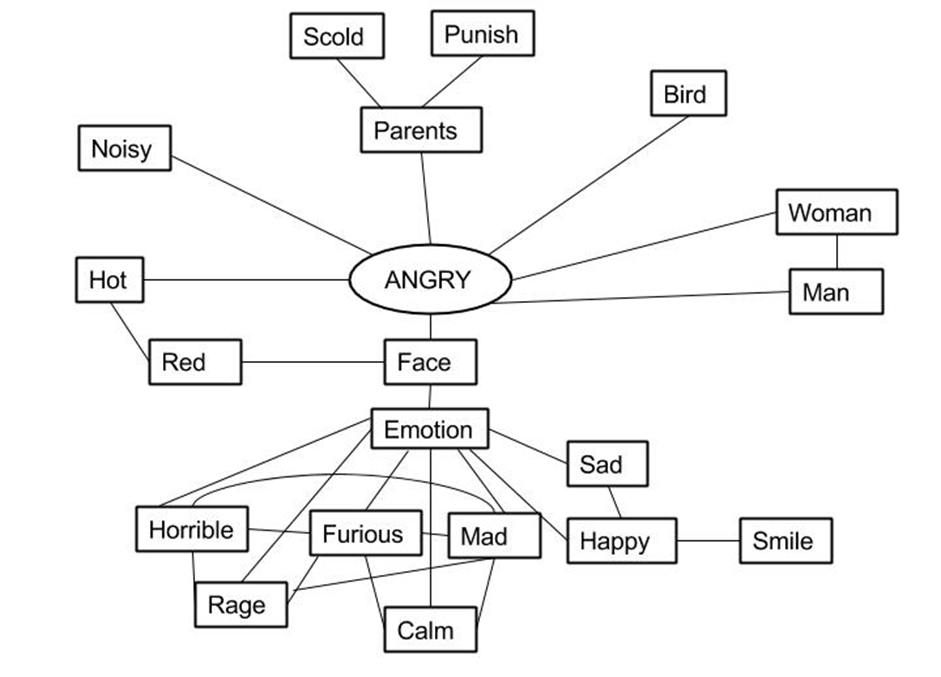
LT2204 Language and Mind
2015-2016
Word Association and Word Games
| Students | Teacher |
|---|---|
|
CHENG, Ka Man, Year 3, BALLA LAM, Yi Ching , Year 3, BALLT |
Dr. CHAN, Yuet Hung Cecilia |
This project aims to investigate how words are stored in mental lexicon through a word association experiment. Sixty young adults were involved in the experiment. They were given 15 primes and required to produce the first word appeared in their mind. The collected data were then analysed through semantic networks. It is discovered that word categories have a great influence on the relationship between the primes and the words given by subjects. Subjects tend to retrieve words through attributive and taxonomic relations when the prime is a noun, but this does not hold when the prime is a verb. Language and culture also contribute to word storage in mental lexicon. Two word games are created based on the experimental results in order to help players activate their mental lexicons.
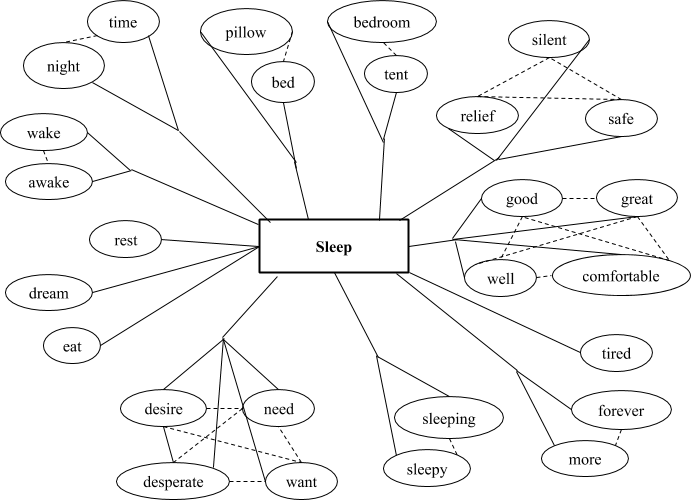
LT3209 Syntax
2016-2017
Grammatical aspects of Thai and English
| Students | Teacher |
|---|---|
|
SAE WONG, Preesa, Year 3, BALLA YIU, Sze Long, Year 3, BALLA |
Dr. LAW, Paul |
The project describes the similarities and differences between the syntax of Thai and English. The data are drawn from independent research in published print media and online resources. It considers the major word classes nouns, verbs and adjectives as well as particular lexical items with restricted distribution like complementizers, negative polarity items, reflexives and reciprocals. It also compares relative clauses in Thai and English. The descriptions are couched in terms of grammatical terms discussed in class lectures showing that the skills learned in class can be applied to new data.
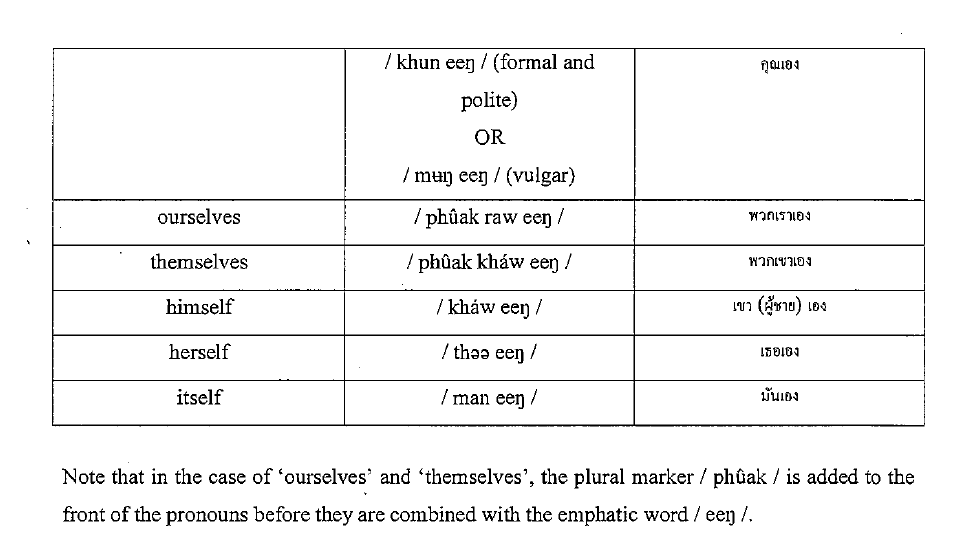
LT3209 Syntax
2016-2017
Urdu
| Students | Teacher |
|---|---|
|
ISHAQ, Arooj Manna, Year 3, BALLA NG, Long Yau Cody, Year 3, BALLA |
Dr. LAW, Paul |
The project describes of the similarities and differences between the syntax of Urdu and English. The project members undertake independent research based on books and online resources to gather data in these two languages and apply the concepts learned in class to new data.
We take this opportunity to explore areas outside the classroom and use the tools taught to us in the analysis of data we have not seen before.
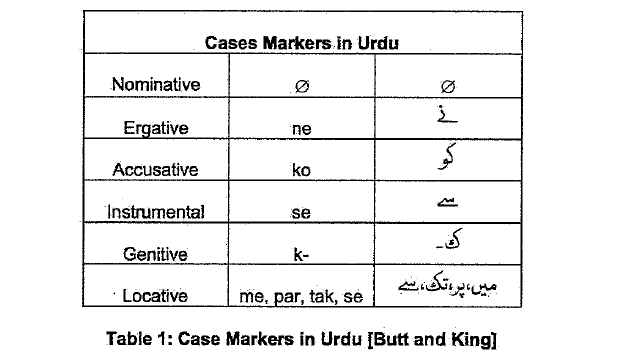
LT3210 Electronic Publishing
2014-2015
Learning Chinese through Chinese Cuisine
| Student | Teacher |
|---|---|
FUNG, Kin Kok, Year 4, BALLT |
Dr. LEE, John Sie Yuen |
We leveraged a small database of bilingual Chinese-English dish names, augmented with photos, to design a language learning website. On the website, users can search for dish names, translate a dish name from English to Chinese, do exercises to learn food-related vocabulary in Chinese, and assess his/her progress with a quiz.
LT3211 Semantics
2017-2018
Interpretation of scope ambiguity in English by English native speakers and Chinese bilingual speakers
| Students | Teacher |
|---|---|
|
KWAN, Ka Lai Lily, Year 4, BALLA WONG, Po Ying Freda, Year 4, BALLA WAN, Yuwei Mia, Year 3, BALLA LI, Mengchen May, Year 2, BALLA |
Dr. TSAI, Cheng Yu Edwin |
This is a study based on previous research of Scontras, Tsai, Mai, and Polinsky. Native English speakers, native Chinese speakers and bilingual speakers were involved. We try to prove that scope ambiguity is not allowed in Chinese, and this property of Chinese will transfer to the second language. Generally, our results are consistent with our main hypothesis (that scope ambiguity is smaller in Chinese but bigger in English by the native English speakers.) By comparing the results, we find that English has large scope ambiguity while Chinese has smaller scope ambiguity, and passive structures will enlarge the scope ambiguity of some sentences in Chinese. Further experiments can also be done on why some bilingual speakers adopt the scope ambiguity, and whether the properties of nouns have influence on the processing of scope ambiguity.
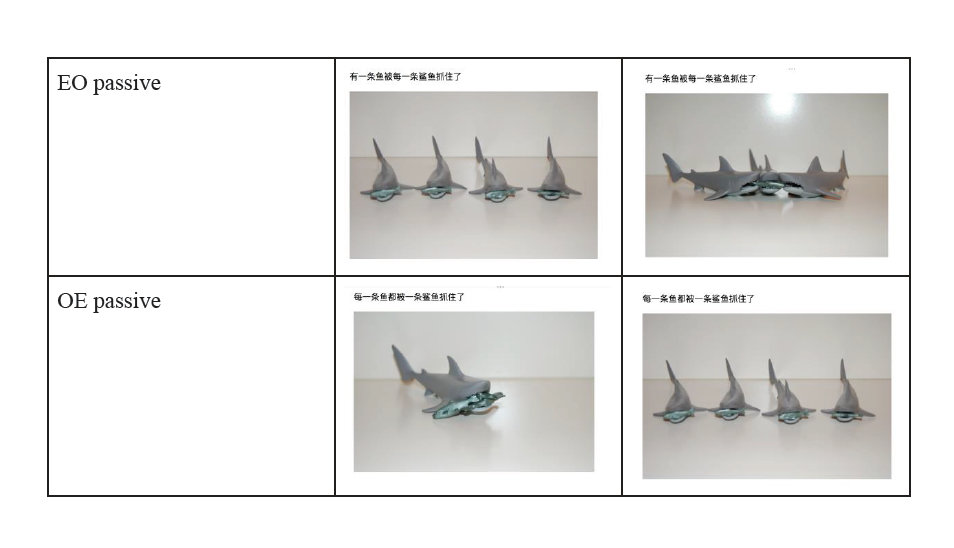
LT3211 Semantics
2017-2018
On the Successive Use of Modal Verbs 可能 and 應該 in Mandarin
| Students | Teacher |
|---|---|
|
CHAN, Man Nga, Year 3, BALLA REN, Jia, Year 4, BATI SO, Hung Chak, Year 4, BACHIN |
Dr. TSAI, Cheng Yu Edwin |
In Mandarin, modal verbs like 可能 and 應該 could be used in sequence. Though there are four possible combinations, only three combinations could be formed by 可能 and 應該. The first one 應該1 epistemic possibility + 可能 epistemic possibility expresses epistemic possibility. The second one 可能 epistemic possibility + 應該1 epistemic possibility is also epistemic, but with a force stronger than necessity. The third one 可能 epistemic possibility + 應該2 deontic necessity expresses deontic modality, with a force slightly lower than necessity.
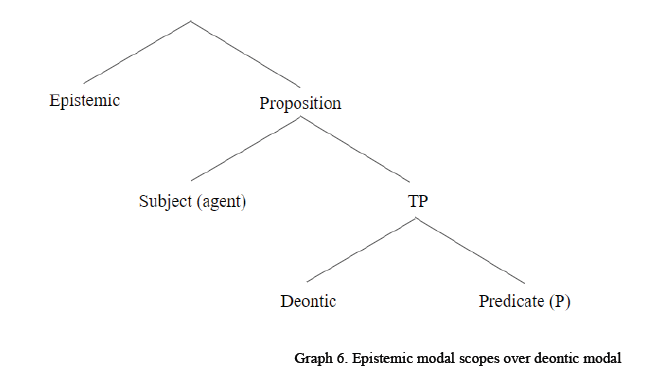
LT3211 Semantics
2016-2017
Does "jing1goi1"(應該) express necessity or possibility in epistemic and deontic modality?
| Students | Teacher |
|---|---|
|
CHAN, Tsz Chung, Year 3, BALLA YEUNG, Nga Yan, Year 3, BALLA SHI, Yibing, Year 3, BALLA SIU, Shuet Ying, Year 3, BALLA |
Dr. TSAI, Cheng Yu Edwin |
This study aims to explore the role of a special modal verb jing1goi1(應該) in Cantonese, wishing to determine whether it expresses necessity or possibility. Another objective is to examine whether its role varies in epistemic and deontic modalities. As a result, this study provides some interesting findings, concluding that the force of jing1goi1 is scalar rather than polar, and its forces do differentiate in deontic and epistemic modalities. This study investigates into the questions which prior researches seldom touched, and it provides some preliminary but inspiring findings.
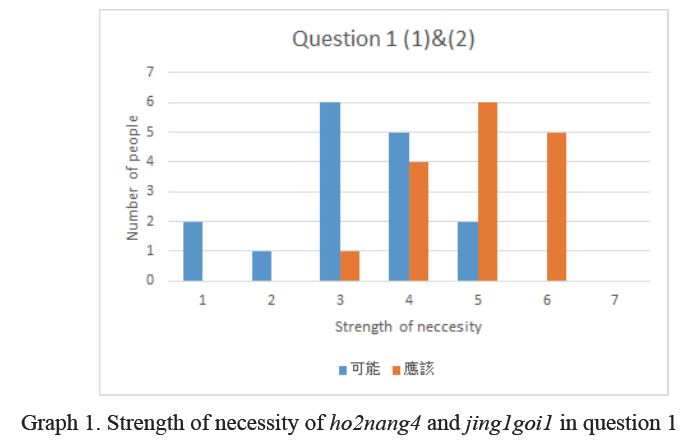
LT3211 Semantics
2015-2016
Aspect verbal particles /zo2/ and /jyun4/ in Cantonese
| Students | Teacher |
|---|---|
|
NG, Yuen Ki Cynthia, Year 3, BALLT NG, Choi Lee Charlie, Year 3, BALLT WU, Ming Kin, Year 3, BALLA YIU, Hin Lok, Year 3, BALLT ZHANG, Jiarui, Year 2, BALLA |
Dr. HARA, Yurie |
In Cantonese, aspectual meanings are normally substantiated by the use of verbal particles. We focus on aspect particles which both state the completion of an action in Cantonese, namely /zo2/ and /jyun4/. Generally speaking, the particle /jyun4/ lexically means “finish”. When it is attached to a verb stem, it means “finish doing something” straightforwardly. The particle /zo2/ is grammatically similar to the “-ed” suffix in English. The meaning of the particle /jyun4/ is relatively more lexical while the meaning of the particle /zo2/ is more grammatical (Chor, 2004).
We conclude that /zo2/ and /jyun4/ are different when they are used in different circumstances. The choice of /zo2/ and /jyun4/ is dependent on the state of the preceding verb: /zo2/ is used to mark both completion and continuous state while /jyun4/ is only used to mark completion state. Last but not least, based on their presupposition in interrogative sentences, /jyun4/ carries presupposition in question while /zo2/ does not.
LT3212 Phonetics
2017-2018
The Sound System of Icelandic
| Student | Teacher |
|---|---|
|
LO, Kwan-lok Samuel, Year 2, BALLA |
Dr. LEE, Wai Sum Vanti |
The essay is a phonetic description of the sound system of Standard Icelandic, a Germanic language, spoken by the large majority of the population in Iceland. It shows that the Icelandic consonant inventory is of medium size and its inventories of the vowels and the diphthongs are small in size. Discoveries include (i) the exotic speech sounds, such as the voiceless nasals and voiceless liquids, and (ii) the phonemic contrast in aspiration, rather than voicing, between plosives, a unique feature of the Icelandic sound system and a rarity in the European languages. The descriptions in the essay are substantiated with language examples.
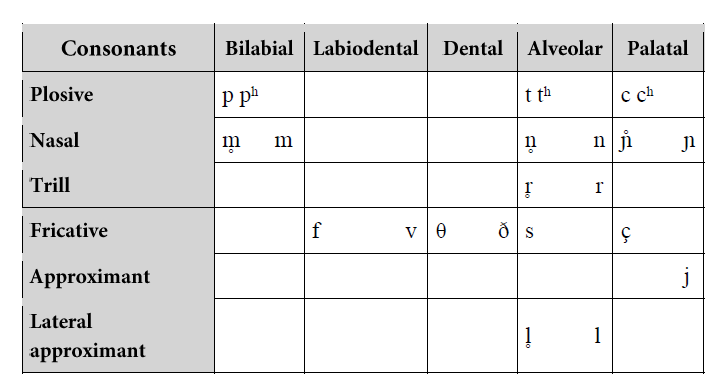
LT3212 Phonetics
2017-2018
The Sound System of Japanese
| Student | Teacher |
|---|---|
|
WONG, Chak-Yin Mavis, Year 1, BALLA |
Dr. LEE, Wai Sum Vanti |
The essay is a description of the phonetic and phonological characteristics of the sound system of Japanese. It reveals that both the consonants and vowels in Japanese have many phonetic variations, presumably compensating the language’s small phonemic inventories of the consonants and vowels. Discoveries of the various types of allophones of the consonant and vowel phonemes are reported, substantiated with language examples. Also given in the essay is a descriptive account of the Katakana and Romaji of the Japanese speech sounds and their corresponding IPA transcription, which is very useful information for learning and studying of the pronunciation of Japanese speech sounds.
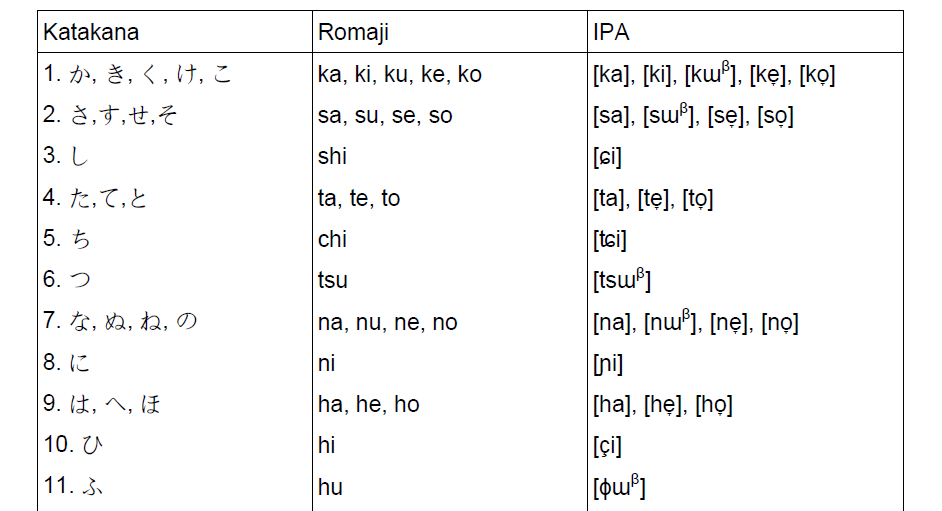
LT3215 Pragmatics
2015-2016
Conversation Analysis: Korean Drama
| Students | Teacher |
|---|---|
|
CHAN, Hoi Pan, Year 4, BALLT CHAN, Tsz Ching Rachel, Year 2, BATI LAI, Shu Nga, Year 4, BALLT LIU, Yuk Ling, Year 4, BALLT YAU, Yee Yeung, Year 4, BALLT YIP, Chung Yan, Year 4, BALLT |
Prof GERNER, Matthias |
This project was a team work of six students. Three students recorded a natural discussion about a Korean drama. Two discourse participants were familiar with the drama content; the third was not very familiar. The conversational goal of the first two participants two was to display their familiarity; the goal of the third participant was to gain a foothold in the discussion. All participants contributed to the conversation analysis in Cantonese. The students discovered the conversation strategies in terms of speech overlap, turn-taking techniques and silence. They correctly associated these strategies with the communicative goals of each discourse participant.
LT3220 Corpus Linguistics
2017-2018
Individual Report
| Student | Teacher |
|---|---|
|
LI, Wang Yau, Year 4, BALLA |
Dr. FANG, Chengyu Alex |
The work is a self-reflection on the corpus linguistics as part of empirical linguistics, an approach that relies on authentic linguistic observations and statistical analyses of the data as both a methodology and a theoretical basis for linguistic research. It has demonstrated a sound understanding of the subject along with the student's own linguistic discoveries through experiments.
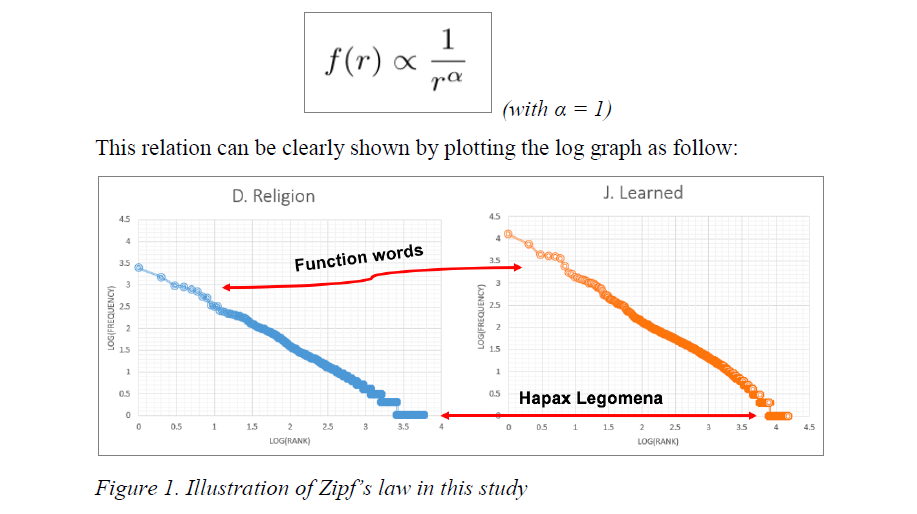
LT4216 Advanced Topics in Linguistics
2017-2018
The Similarities and Differences in the Semantics and Syntactical function of the Sentence-final Particle 啊(/a/) in Cantonese and Taiwanese
| Student | Teacher |
|---|---|
|
NG, Long Yau, Year 4, BALLA |
Dr. TSAI, Cheng Yu Edwin |
The paper focuses on the Cantonese sentence-final particles which spoken in Hong Kong and the South Min language which spoken in Taiwan for analysis. Since Hong Kong people and Taiwanese has a more similar value and attitude, and their culture and information flow is active, open and reliable, it is worth to study their similarity and difference between the two languages in the usage of sentence-final particles. The research aims to improve the two nations intimacy during daily conversation. It also wants to explore whether the same sentence final particle will produce different meaning in Cantonese and South Min language. The paper intends to reduce the misunderstanding during the conversation between the two regions.
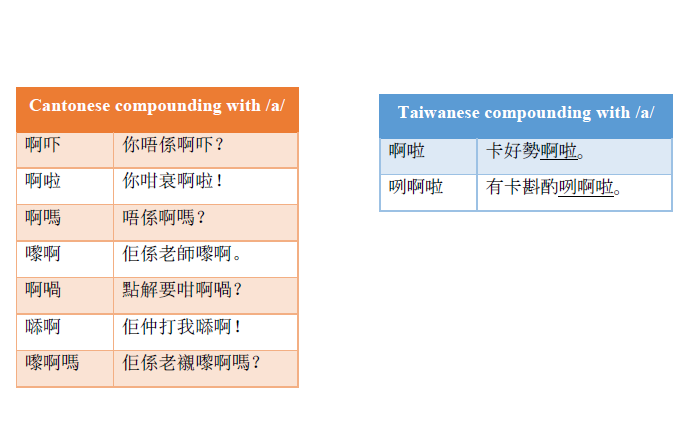
LT4216 Advanced Topics in Linguistics
2016-2017
Formal Semantic Analysis of Cantonese expressive adjective laap6saap3
| Students | Teacher |
|---|---|
|
CHAN, Kong Yau Vanessa, Year 4, BALLA LAM, Yi Ching Connie, Year 4, BALLT LO, Cheuk In Sarah, Year 4, BALLT WONG, Ming Ling Crystal, Year 4, BALLA |
Dr. HARA, Yurie |
Laap6saap3 (垃圾) has been used frequently in our daily lives. We usually say laap6saap3 when we want to indicate that specific thing is useless. We are thus interested in investigating whether laap6saap3 is a conventional implicature (CI) defined by Potts (2003) as introduced in our lectures. Surprisingly, we found that laap6saap3 is not a CI because it does not fit all CI properties. When we analyzed further, we found that laap6saap3 is an at-issue entailment. However, it is not a uni-dimensional at-issue entailment which we always encounter, but a multi-dimensional one which one or more at-issues are included in the sentence containing laap6saap3.

LT4216 Advanced Topics in Linguistics
2016-2017
CI Analysis of 嘅 ‘ge2’
| Students | Teacher |
|---|---|
|
KAN, Ka Ho, Year 4, BALLA LO, Tsz Yan, Year 4, BALLT LUI, King Yan, Year 4, BALLT WU, Ming Chun, Year 4, BALLA |
Dr. HARA, Yurie |
In Cantonese, a sentence final particle is used to modify an entire proposition. The declarative ‘ge2’ is one of the particles used to make an emphasis. This project aims to ascertain the conventional implicature (CI) status of 'ge2' by analyzing empirical data. It was found that ‘ge2’ demonstrates the four properties which are unique to CIs. They are: Lexicality, Commitment, Speaker’s Orientation and Independence of At-issue Meanings (Potts, 2003). Our hypothesis is that the Cantonese sentence final particle ‘ge2’ carries a secondary meaning ‘the speaker does not fully agree…’ and such secondary meaning is a CI. A formal analysis of ‘ge2’ based on LCI is provided to show the derivation of the four characteristic properties.

LT4223 Experimental Phonetics
2017-2018
An acoustic analysis of the Korean plosives produced by native speakers
| Student | Teacher |
|---|---|
|
CHEUNG, Man Chi Cathleen, Year 4, BALLA |
Dr. LEE, Wai Sum Vanti |
This project investigates the acoustic features that differentiate the three plosive types in Korea, namely lax [p t k], tense [p’ t’ k’], and aspirated [ph th kh] in the speech of native Korean speakers, male and female. The study makes the following discoveries: (i) a long VOT of the aspirated and the lax plosives is the distinctive feature differentiating the two plosive types from the tense one, (ii) a high F0 of the following vowel after the aspirated plosives is the distinctive feature differentiating the lax and the tense plosives, and (iii) the intensity of the following vowel does not play a part in differentiating the three plosive types.
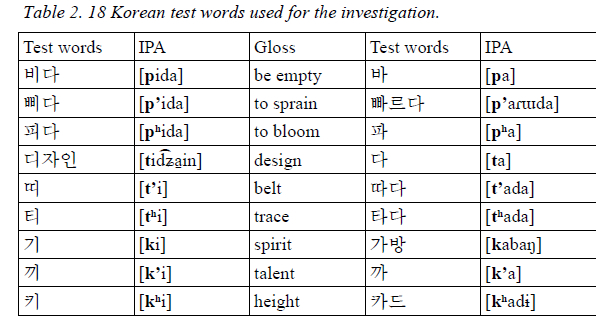
LT4223 Experimental Phonetics
2017-2018
Durations of the geminates in Japanese
| Student | Teacher |
|---|---|
|
LAM, Cheuk Man Phoebe, Year 4, BALLT |
Dr. LEE, Wai Sum Vanti |
This project investigates the temporal patterns of the geminate consonants, including stops [tt] and [kk], affricate [čč], and fricative [ss] in Japanese, as compared to the singleton counterparts [t, k, č, s], through taking duration measurements of the speech samples from native Japanese speakers, male and female. The study makes discovery of the facts, which are at variance with the traditional description of the Japanese language, that (i) the geminate consonants are more than the doubling of their singleton counterparts; (ii) the geminate stops [tt, kk] and affricate [čč] have a long pause closure, while the geminate fricative [ss] has no pause but a lengthened frication; and (iii) all the geminate consonants follows a long preceding vowel.
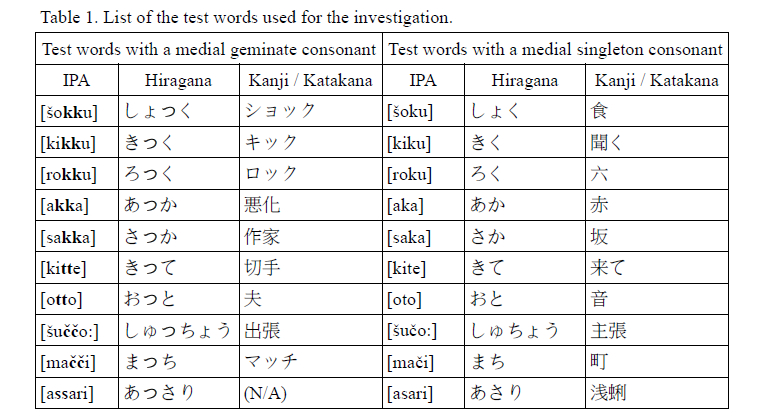
LT4227 First Language Acquisition
2018-2019
Early Words and Language Development of an English-Speaking Child
| Student | Teacher |
|---|---|
|
SO, Hung Chak, Year 5, BACHIN/BALLA |
Dr. CHAN, Yuet Hung Cecilia |
In this paper, we analyze the early words that an English-speaking child Ross produced when he was 1 year and 6 months old. The results align with the previous studies. Then, we compare that conversation with the one that was recorded when he was 2 years and 6 months old. We find that the older he is, the better lexical (vocabulary size and types of nouns and verbs), morphological (articles and contractible copulas), syntactic (negatives and wh-questions) and pragmatic (making requests and maintenance of topics) developments he has, which can be explained by the cognitive theory and social interaction theory.
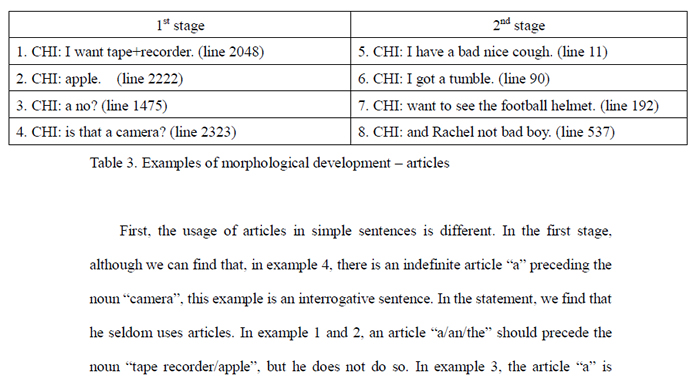
LT4227 First Language Acquisition
2016-2017
Early Words and Language Development of an English-Speaking Child
| Students | Teacher |
|---|---|
|
HUI, Carr Ie, Year 4, BALLT LI, Yim Shan, Year 4, BALLT |
Dr. CHAN, Yuet Hung Cecilia |
The paper aims to discover the patterns of language development of children by reviewing data from the Providence Corpus. The spontaneous speech between an English-speaking child named William and his parent who speak Standard American English are analyzed. The role of mother in early language development is also examined by comparing the transcript of William aged 1 year 8 months with another that aged 3 years 3 months. William’s language development is analysed in terms of lexical, morphological, syntactic and pragmatic perspective. Meanwhile, Piaget’s Cognitive Theory is applied to account for the overall language development of the child.
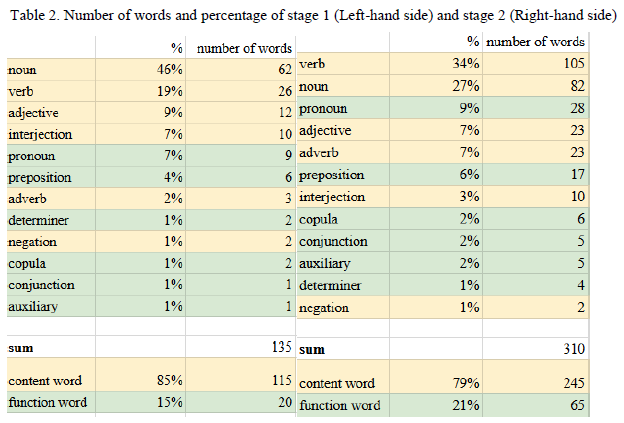
LT4227 First Language Acquisition
2016-2017
Early Words and Language Development of an English-Speaking Child
| Student | Teacher |
|---|---|
|
NG, Yuen Ki Cynthia, Year 4, BALLT |
Dr. CHAN, Yuet Hung Cecilia |
In this project, two data files, nai28.txt and nai81.txt, extracted from the CHILDES database, were selected to investigate the language development of an English-speaking child named Naima. Her speech productions at the age of 1 year and 8 months old and 3 years and 3 months old were analysed and her language developmental patterns were discovered. The project is outlined as follows: (1) Analyses of Naima’s early words and the role of parents in language development; (2) Analyses of the child’s four aspects of language development, including lexical, morphological, syntactic and pragmatic development; (3) A theoretical explanation on the child’s language development.
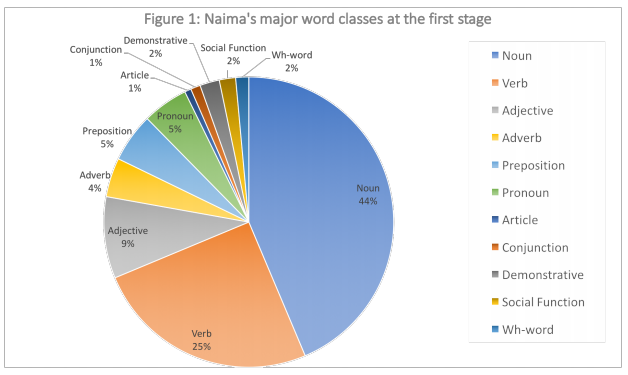
LT4235 Project
2019-2020
The Syntax of Modal Auxiliaries in Northern Thai
| Student | Teacher |
|---|---|
|
YU, Joey, Year 4, BALLA |
Dr. TSAI, Cheng Yu Edwin |
This paper looks into the syntax of modal auxiliaries in Northern Thai, a language spoken in the six provinces of the Northern Thai region. The purpose of the present paper is to examine the syntactic properties of Northern Thai modal sentences from a transformational-generative point of view. The paper has concluded on the tendency in which a particular Northern Thai modal basis corresponds to a particular structure, i.e., an instantiation of syntax-semantics correspondence.
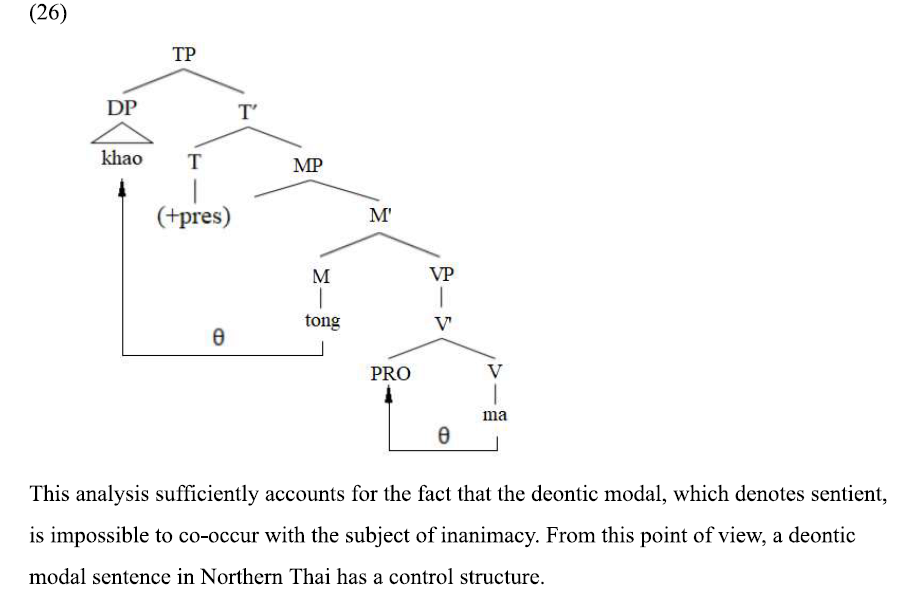
LT4235 Project
2017-2018
Phonology-syntax interplay with respect to Tone 3 sandhi in Mandarin Chinese
| Student | Teacher |
|---|---|
|
SHI, Yibing, Year 4, BALLA |
Dr. LEE, Wai Sum Vanti |
The project investigates the phonology-syntax interplay with respect to Tone 3 sandhi in Mandarin Chinese, through an analysis of the speech data from ten Mandarin speakers, five male and five female. The F0 contours of a sequence of Tone 3 on the test utterances show that in Mandarin the syntactic structure plays an important role of determining the application of Tone 3 sandhi across the component syllables in the utterances. The data affirm the cyclical application of Tone 3 sandhi from left to right and from the innermost constituent group to the outer ones, as what was reported in the previous studies. Discoveries in the study provide with a better understanding of the alignment between the prosodic and syntactic domains in language.

LT4235 Project
2017-2018
An Acoustic Analysis of Cantonese Vowels and Tones Produced by Hearing-Impaired Speakers
| Student | Teacher |
|---|---|
|
TSOI, Ching-Yin Irene, Year 4, BALLA |
Dr. LEE, Wai Sum Vanti |
This project investigates the acoustic characteristics of Cantonese vowels and tones produced by young adult speakers, male and female, with hearing impairment. Speech samples elicited from six hearing-impaired (HI) Cantonese speakers were compared with those from two Cantonese speakers of normal hearing. Results show that vowel prolongation and centralization are observable in the speech of HI speakers, but no significant effect on differentiation of the vowels is detected. By contrast, the HI speakers are less successful in producing the tones, in particular having the problem of flattening the F0 contours of the contour tones, which leads to the merging with the level tones. Discoveries in the project also include shedding further light on the effect of hearing impairment on the deficiency in speech production.

LT4235 Project
2016-2017
A phonetic study of the sound system of Taipung (Dapeng) dialect
| Student | Teacher |
|---|---|
|
CHEUNG, Chi Hung Maurice, Year 4, BALLT |
Dr. LEE, Wai Sum Vanti |
This is the first phonetic study presenting experimental data on the sounds of Taipung, a dialect spoken in Dapeng Peninsula, Shenzhen, China. The acoustic data obtained reveal that the Taipung sound system has (i) 17 initial consonants [p ph t th k kh ts tsh f s h m n ŋ l w j], (ii) 6 final consonants [p t k m n ŋ], (iii) 2 syllabic nasals [m̩ ŋ̍], (iv) 6 vowels [i u o ɔ a ɐ]; (v) 9 diphthongs [iu ia io iɔ oi ɐi ɐu ai au], and (vi) 7 tones [55 33 22 21 25 5 3]. This study also discovers that Taipung bears striking similarities in the sound system to Cantonese and Hakka, and it has no observable historical relationship to Mandarin phonetically as claimed in the literature.
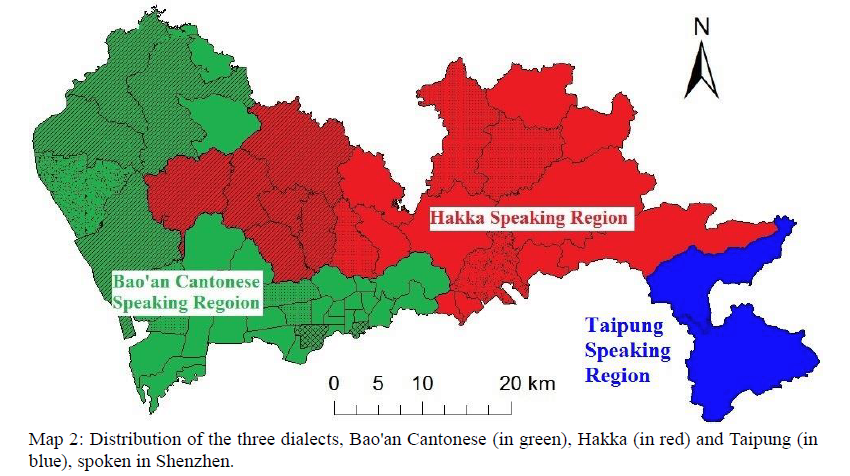
LT4235 Project
2016-2017
Merger of the syllable-initial [n-] and [l-] in Hong Kong Cantonese
| Student | Teacher |
|---|---|
|
NG, Choi Lee Charlie, Year 4, BALLT |
Dr. LEE, Wai Sum Vanti |
This is the first phonetic investigation of the merger of the syllable-initial [n-] and [l-] of Hong Kong Cantonese (HKC) in production and perception. An acoustic analysis and identification tests were carried out to obtain spectrographic and perceptual properties of [n-] and [l-] from native HKC speakers. It is discovered that the merger of the initial [n-] and [l-] in HKC has not yet completed. In production, [n-] is more often pronounced as [l-] than [l-] pronounced as [n-]. Perceptually, [n-] and [l-] are in general distinguishable. The findings in this study contribute to a fuller understanding of the roles of production and perception and their interrelationship in the merger of [n-] and [l-] in HKC.
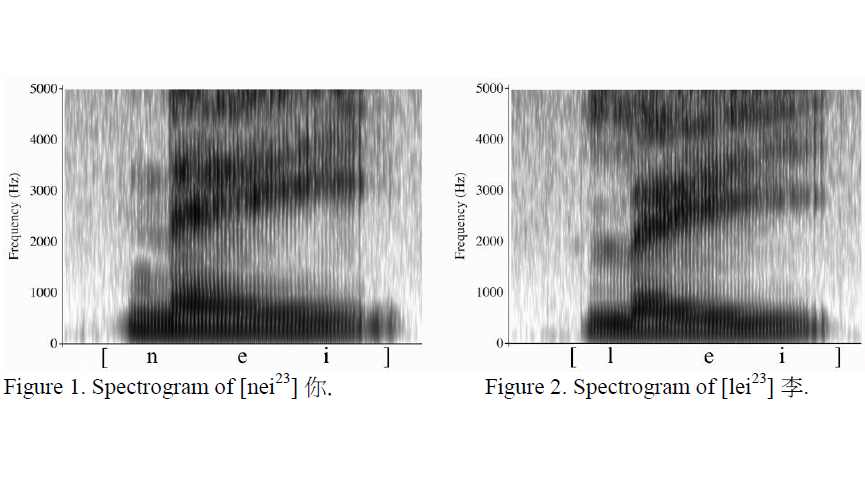
LT4241 Topics in Syntax
2016-2017
Interrogative Sentence Final Particles of Cantonese – aa4 and me1
| Student | Teacher |
|---|---|
|
MA, Ming Wai, Year 4, BALLA |
Dr. TSAI, Cheng Yu Edwin |
Sentence Final Particles (SFP) play an important role in Chinese languages as they can modify the mood or even determine the meaning of a sentence. This paper aims to depict the linguistic features of two interrogative SFPs – aa4 and me1. Speakers would use aa4 when he/she believes that the proposition is true and seek confirmation. Me1 carries an additional meaning that the speaker’s belief contradicts the proposition of the question. By observing the distribution of aa4 and me1 in utterances used in daily speech, syntactic, semantic and pragmatic properties of the three particles will be investigated. The pattern of SFP clusters will also be addressed in this paper. This grammatical category is commonly found in Cantonese but rarely seen in Mandarin grammar. Yet, the order of the SFPs in a cluster are bounded by rules that will be discussed in this paper.
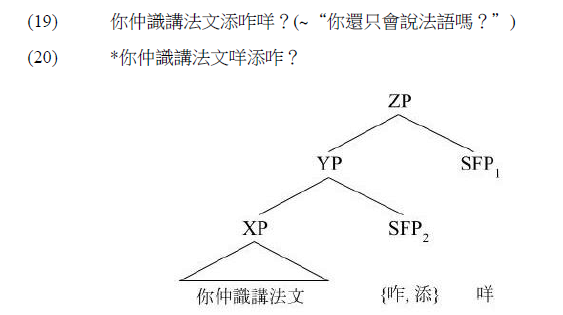
LT4241 Topics in Syntax
2016-2017
Distribution differences of negation markers in Cantonese
| Student | Teacher |
|---|---|
|
WONG, Ming Ling, Year 4, BALLA |
Dr. TSAI, Cheng Yu Edwin |
The negation markers in Cantonese, namely ng4 唔, mou5 冇, mei6 未 and mai5 咪, are all interpreted as not in English, functioning to negate the meanings of phrases. Nevertheless, in Cantonese, these four markers differ in distributions. They, in most cases, are in complementary distribution in terms of syntax and semantics. For example, the meaning of the sentence may vary according to the marker used although they appear in seemingly identical sentence structure. This paper investigates the distributions of four negations in Cantonese and finds out the subtle differences among them. It is hypothesized that the variations can be accounted for the aspectual selection; therefore, this paper puts emphasis on how the negation markers are dissimilar to one another in view of situation aspect and viewpoint aspect.

LT4235 Project
2015-2016
Production of the English vowels in Cantonese and Japanese children
| Student | Teacher |
|---|---|
|
WONG, Yik Ching, Year 4, BALLT |
Dr. LEE, Wai Sum Vanti |
The project investigates the production of English vowels by Cantonese-speaking and Japanese-speaking children, male and female, of 6-7 years of age. A production experiment was conducted, involving collection of speech samples and acoustic analysis of formant frequencies (F1F2) of the English vowels /i ɪ ɛ æ u ʊ ɔ ʌ ɒ ɑ ɜ(ɝ)/ from the two groups of children. Errors in pronunciation of the vowel sounds are observed in the speech of both Cantonese and Japanese children. In general, Japanese children perform better than Cantonese children in producing the English vowels, which is assumed due to weak phonological awareness in Cantonese speakers. Cantonese children tend not to distinguish the English vowels /ɛ/ and /æ/ and also /ɔ/ and /ɒ/. Similar errors in English vowel production are reported in adult speech in the previous studies, suggesting that age is not an important factor in L2 acquisition of the English vowel sounds. This study has provided pedagogically useful information for teaching and learning of the vowel sounds of English.
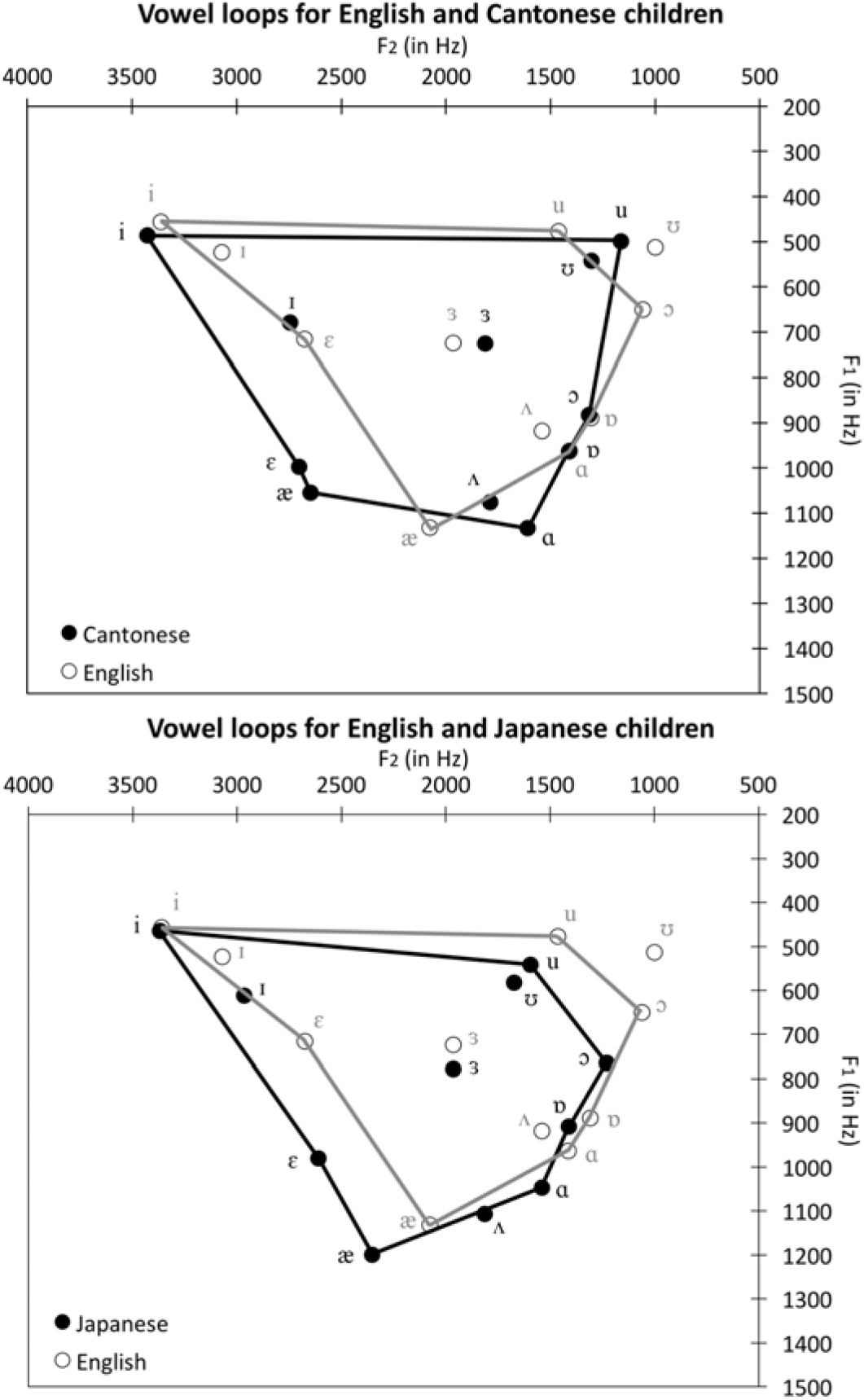
LT4235 Project
2014-2015
An Acoustic Analysis of Mandarin Sibilants Produced by Cantonese Speakers
| Student | Teacher |
|---|---|
WONG, Cheuk Kin, Year 4, BALLT |
Dr. LEE, Wai Sum Vanti |
This study investigates the production of the three sets of sibilants in Mandarin, i.e. the denti-alveolar [ʦ, ʦʰ, s], post-alveolar (or retroflex) [tʂ, tʂʰ, ʂ], and alveolo-palatal [ʨ, ʨʰ, ɕ], produced by four university students, 2 male and 2 female, in Hong Kong whose native language is Cantonese, through acoustic analysis. Frequency values for the noise peak and noise range, which are two major acoustic properties for distinction among the sibilants in different place categories, were measured for the test sibilants produced by the subjects. In comparison of the data from a native speaker of Mandarin, some patterns of the sibilant production are generalized for the Cantonese subjects.
Generally speaking, the Cantonese subjects have not mastered the distinction of the three sets of Mandarin sibilants. The denti-alveolar sibilants [ʦ, ʦʰ, s] are most frequently mispronounced by the subjects; both denti-alveolar [ʦ, ʦʰ, s] and alveolo-palatal [ʨ, ʨʰ, ɕ] sibilants cannot be identified as one place category in most cases, which are not produced within a boundary of anyone of the three sets of sibilants and/or not consistently mixed up with other sibilant equivalents. The production of the retroflex [tʂ, tʂʰ, ʂ] is the best, and they can be clearly differentiated from the other two sets of sibilants. The patterns of errors in the production of Mandarin sibilants for the Cantonese subjects are similar to those for the Korean, Japanese, and Vietnamese subjects reported in Chung and Si (2009). The findings of this study contributed to our deeper understanding towards the difficulties in the production of Mandarin sibilants of Cantonese learners, paving the way for Mandarin teaching or further investigation.
LT4239 Conversation Analysis
2018-2019
Participants' attitude and eagerness on competing speakership with the influence of the nature of dialogue: An analysis on gaps and overlaps
| Students | Teacher |
|---|---|
|
WONG, Hei Shing, Year 4, BALLA WONG, Yee Ching, Year 4, BALLA YU, Suet Ying, Year 4, BALLA |
Dr. CATEDRAL, Lydia |
Overlaps and gaps occur frequently and naturally in our daily conversation. They are important as preference and willingness markers. This paper will analyse three recorded conversations between friends. By studying overlaps and gaps as the focus, we can understand how its frequency and pattern correlate with the speakers’ preference and willingness to speak. During the analysis, the nature of the conversation was taken into consideration. Speakers in excerpt 1 and 2 were negotiating consensus in decision making while speakers in excerpt 3 tended to have information giving only. It is expected that speakers tend to involve more in making consensus if the decision has direct influence on them. As a result, it may also account for the reason of the various overlapping pattern. The micro-level conversational structure on gaps and overlaps significantly connect with macro-level social structure by revealing the eagerness and attitude adopted by the speakers.

LT4239 Conversation Analysis
2014-2015
A Gaze is Worth a Thousand Words: Functions of Eye Gaze in Negotiation
| Students | Teacher |
|---|---|
|
LAW, Ka Mei Elizabeth, Year 4, BALLT LAW, Man Ka Crystal, Year 4, BALLT WONG, Sze Lam Tiffany, Year 4, BALLT |
Dr. ZHANG, Wei |
This project explores eye gaze in conversation. It is based on the students own video recording of natural conversation. The students' decision to work on this topic grew out of their own discovery of a feature which is salient in the recorded conversation. To explore the function of eye gaze, the students went beyond the course syllabus and conducted an independent study during which they learned the skill for analysing video data of natural conversation and discovered how language and body work together to achieve meaning in the multimodality of human social interaction.
LT4242 Topics in Semantics
2015-2016
Conventional Implicature Analysis of Cantonese Mai6…lo1 Construction
| Students | Teacher |
|---|---|
|
NG, Ka Kei, Year 4, BALLT TAM, Lai Mei, Year 4, BALLT YEUNG, Yu Kit, Year 4, BALLT |
Dr. HARA, Yurie |
We analyse the meaning induced by the Cantonese mai6…lo1 construction with regard to Potts’ view of conventional implicature (CI) and his logic of CI. In the project, we discover a sentence can be multidimensional and has more than one meaning. We learn that the mai6…lo1-inducing meaning possesses some properties which make it a CI and these properties can be manifested in the manner of formal semantics using the logic of CI.
Youtube video

Note: Text-to-speech function built in Mac OSX 10.11 was employed in narration production (reference link).
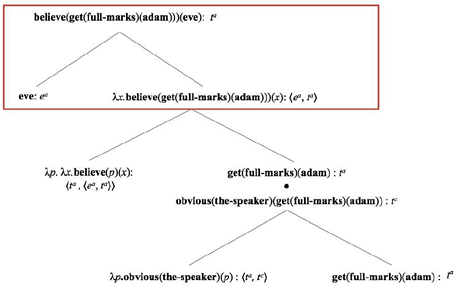
Full report
LT4254 Psycholinguistics of Reading
2017-2018
Mapping the reading circuitry for skilled pre- and post-lingual deaf Chinese readers: An fMRI study of semantic and phonological processing
| Students | Teacher |
|---|---|
|
CHAN, Tsz Chung, Year 4, BALLA LI, Wang Yau, Year 4, BALLA SO, Hung Chak, Year 4, BACHIN TSOI, Ching Yin, Year 4, BALLA |
Dr. HUANG, Hsu Wen |
A previous study by Emmorey et al. (2013) has been conducted to investigate the neural circuitry of English deaf readers in reading written words. However, differences in linguistic features among languages may suggest the possibility of variations in neural circuitry for reading Chinese and English. Therefore, we propose a modified experiment for Chinese deaf readers. We attempt to investigate the semantic and phonological processing of written words by three groups of highly skilled readers, pre-lingual deaf readers, post-lingual deaf readers and normal hearing readers. The expected result of the study is going to contribute to further studies of neural mapping in reading Chinese words and that of hearing-impaired people. More importantly, the result can suggest the importance of auditory input in reading Chinese, which underlines the usefulness of hearing device.
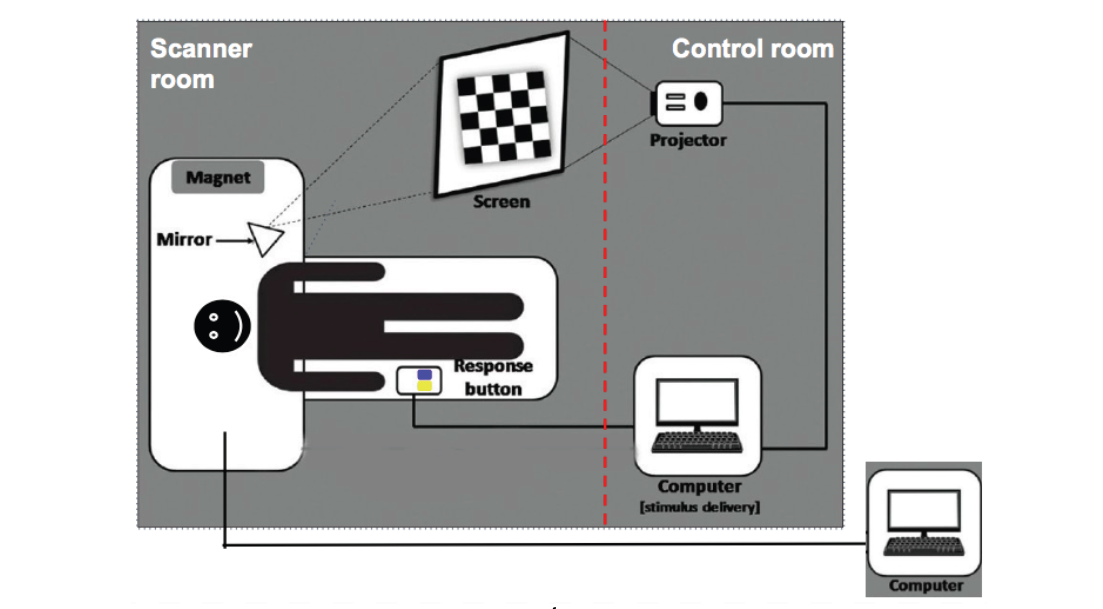
LT4254 Psycholinguistics of Reading
2017-2018
To what extent does the language proficiency of the L2 English speakers affect the Pun Processing in Psycholinguistic perspectives?
| Students | Teacher |
|---|---|
|
LAM, Wai Kit Ricky, Year 4, BALLA LEE, Oi Yee Michelle, Year 4, BALLA MAN, Yi Ching Clarice, Year 4, BALLA TSE, Ka Fai Byron, Year 4, BALLT WONG, Zoi Tung Natalie, Year 4, BALLA |
Dr. HUANG, Hsu Wen |
Puns are the verbal contexts with an existence of intentional exploitation of phonetic processes so as to suggest multi-meanings simultaneously (Guidi, 2012). In other words, puns refer to wordplay which contains two meanings with one being implicit. Ambiguity processing is required in the pun understanding. There are several pun types, such as homophonic, homographic, homonymic, compound, etc. Pun is one of the mostly used figures of speech in advertisement (Chakroun,2014). 40% of advertisements include puns (Leigh,1994).With the popularity of using pun, a study would like to be conducted to investigate whether language proficiency of L2 English speakers will affect pun processing in psycholinguistic perspective. In this study, two major foci will be based on two aspects. First, using eye-tracking experiment to understand how speakers perceived ambiguous words; the second part will look into how brain contributes to the response of L2 English speakers in different language proficiency with EEG test (N400).

Disclaimer
To make use of any material hosted at this page, you must give appropriate credit, provide a link to the source of origin, and indicate if changes were made. You may do so in any reasonable manner, but not in any way that suggests the copyright owners endorses you or your use.
You may not use the material for commercial purposes.
